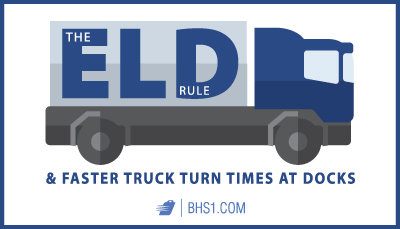We use cookies to make your experience better. To comply with the new e-Privacy directive, we need to ask for your consent to set the cookies. Learn more.
The Electronic Logging Device Rule and Faster Truck Turn Times at Docks
Pretty soon, the federal Electronic Logging Device rule that (mostly) went into effect on December 18 of last year will unleash full penalties for violations. As you'll recall, late last year, truck drivers protested the oncoming mandate, which requires drivers to track all hours in the truck through electronic logging devices. Officials with the Federal Motor Carrier Safety Administration hope this will reduce issues surrounding driver fatigue and scheduling.
President Trump responded to the outcry by slowing down implementation. At least through March, drivers who are caught without e-logging devices may receive a citation, but these won't count toward the firm's safety record, and drivers will be allowed to keep moving along their routes. However, and this is the important point to operators of logistics channels and distribution centers: That grace period is set to expire on April 1.
It's safe to assume that shipping firms will pay attention to how long their drivers sit at docks, waiting on shipments to load. And while there's no official blacklist of shippers, it's in the carrier's best interest to choose partners who can get their truckers in and out as quickly as possible.
That said, there are a few simple, low-cost ways to improve productivity at loading docks. Implement these today to avoid taking a hit from the ELD rule as it continues to change the shipping industry in the United States:
- Implement a drop trailer program
- Palletize anything and everything possible.
- Use "geo fencing" to create dynamic dock plans.
While drop trailers are often the fastest way to send freight on its way quickly, traditionally, only high-volume shippers pursued the strategy. It's a simple matter of logistics: The fewer bays available, the fewer can stage a fully loaded trailer for a distant carrier.
However, any distribution center with extra room in the yard can designate drop trailer lanes without occupying a full bay. They just need a Yard Ramp that's designed for safe lift truck traffic and they'll be able to load drop trailers in the yard itself. Just like that, DCs of any size can implement a quick drop trailer program, and carriers will certainly notice the commitment to reducing origin dwell times.

Not to state the obvious, but you'll never load loose pieces as quickly as fully loaded pallets. But palletizing freight requires extra lead time, and, without the right ergonomic equipment, this repetitive task can lead to worker injuries.
The solution is to equip shipping/receiving areas with Pallet Carousel & Skid Positioners. These self-leveling lift tables keep all work close to the employee's body, cutting down on the ergonomically risky movements like stretching, reaching, and bending.
One of the major takeaways from a 2013 "Speed Docking" study conducted by the Amsterdam University of Applied Sciences was the power of "geo docking."
In this system, signals from a truck's onboard computer alert DC planning teams when the vehicle will soon arrive. Managers can then choose an available dock, ensure the shipment is ready, and route the truck straight to a specific loading bay.
By now, the effects of the ELD rule are beginning to spread throughout the industry. This should accelerate when officers begin enforcing strict compliance in April. With an efficient, quick-moving dock, shippers can establish themselves as preferred vendors for their carriers, forging partnerships that will improve logistics throughout the supply chain.
References:
United States. "49 CFR Parts 385, 386, 390, and 395 Electronic Logging Devices and Hours of Service Supporting Documents; Final Rule." GPO. Federal Register, Vol. 80, No. 241, 16 Dec. 2015. PDF. 11 Dec. 2017.
Van Amstel, Walther Ploos. "A framework for improving reliability of truck turn times in FMCG transport networks." ResearchGate. CSMCP Conference, Oct. 2013. Web. 11 Dec. 2017.
